Effective Communication in Care Settings: A Detailed Report
VerifiedAdded on 2023/01/06
|9
|3281
|26
Report
AI Summary
This report comprehensively examines communication and information handling within care settings. It begins by identifying the reasons for communication and explores how effective communication impacts all aspects of work, emphasizing the importance of observing individual reactions. The report then delves into barriers to communication and identifies resources to improve communication effectiveness. Further, it defines confidentiality, describes situations requiring information disclosure, and explains how to seek advice on confidentiality. The report then transitions to handling information in care settings, outlining relevant legislation, such as the Data Protection Act of 2018, and explaining the importance of secure information systems. It concludes by describing how to access guidance and the actions to take when concerns arise regarding information handling, providing a thorough overview of the crucial elements of effective communication and information management in care environments. This report is a valuable resource for students studying healthcare and related fields, contributed to Desklib, a platform providing AI-based study tools.

REPORT
Paraphrase This Document
Need a fresh take? Get an instant paraphrase of this document with our AI Paraphraser
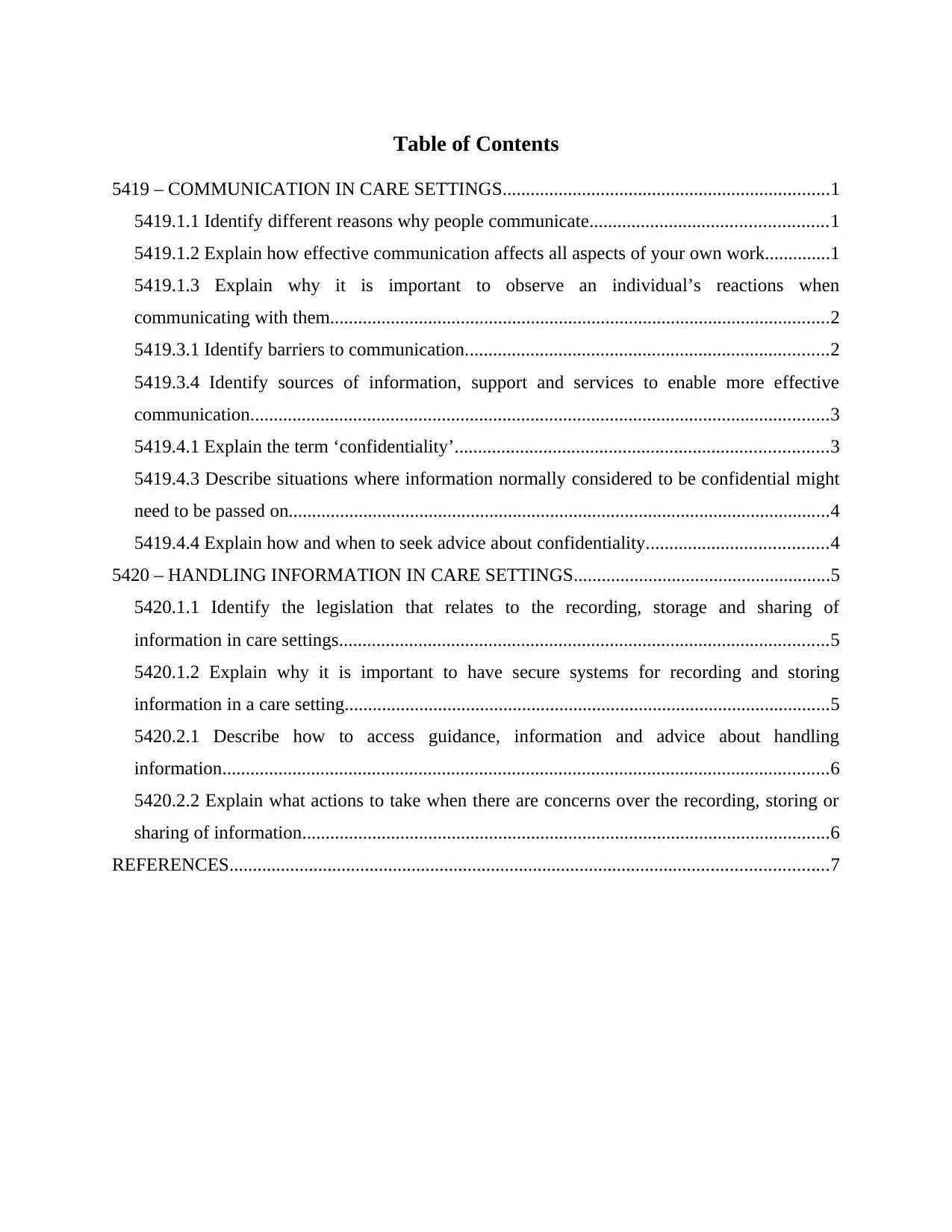
Table of Contents
5419 – COMMUNICATION IN CARE SETTINGS......................................................................1
5419.1.1 Identify different reasons why people communicate...................................................1
5419.1.2 Explain how effective communication affects all aspects of your own work..............1
5419.1.3 Explain why it is important to observe an individual’s reactions when
communicating with them...........................................................................................................2
5419.3.1 Identify barriers to communication..............................................................................2
5419.3.4 Identify sources of information, support and services to enable more effective
communication............................................................................................................................3
5419.4.1 Explain the term ‘confidentiality’................................................................................3
5419.4.3 Describe situations where information normally considered to be confidential might
need to be passed on....................................................................................................................4
5419.4.4 Explain how and when to seek advice about confidentiality.......................................4
5420 – HANDLING INFORMATION IN CARE SETTINGS.......................................................5
5420.1.1 Identify the legislation that relates to the recording, storage and sharing of
information in care settings.........................................................................................................5
5420.1.2 Explain why it is important to have secure systems for recording and storing
information in a care setting........................................................................................................5
5420.2.1 Describe how to access guidance, information and advice about handling
information..................................................................................................................................6
5420.2.2 Explain what actions to take when there are concerns over the recording, storing or
sharing of information.................................................................................................................6
REFERENCES................................................................................................................................7
5419 – COMMUNICATION IN CARE SETTINGS......................................................................1
5419.1.1 Identify different reasons why people communicate...................................................1
5419.1.2 Explain how effective communication affects all aspects of your own work..............1
5419.1.3 Explain why it is important to observe an individual’s reactions when
communicating with them...........................................................................................................2
5419.3.1 Identify barriers to communication..............................................................................2
5419.3.4 Identify sources of information, support and services to enable more effective
communication............................................................................................................................3
5419.4.1 Explain the term ‘confidentiality’................................................................................3
5419.4.3 Describe situations where information normally considered to be confidential might
need to be passed on....................................................................................................................4
5419.4.4 Explain how and when to seek advice about confidentiality.......................................4
5420 – HANDLING INFORMATION IN CARE SETTINGS.......................................................5
5420.1.1 Identify the legislation that relates to the recording, storage and sharing of
information in care settings.........................................................................................................5
5420.1.2 Explain why it is important to have secure systems for recording and storing
information in a care setting........................................................................................................5
5420.2.1 Describe how to access guidance, information and advice about handling
information..................................................................................................................................6
5420.2.2 Explain what actions to take when there are concerns over the recording, storing or
sharing of information.................................................................................................................6
REFERENCES................................................................................................................................7
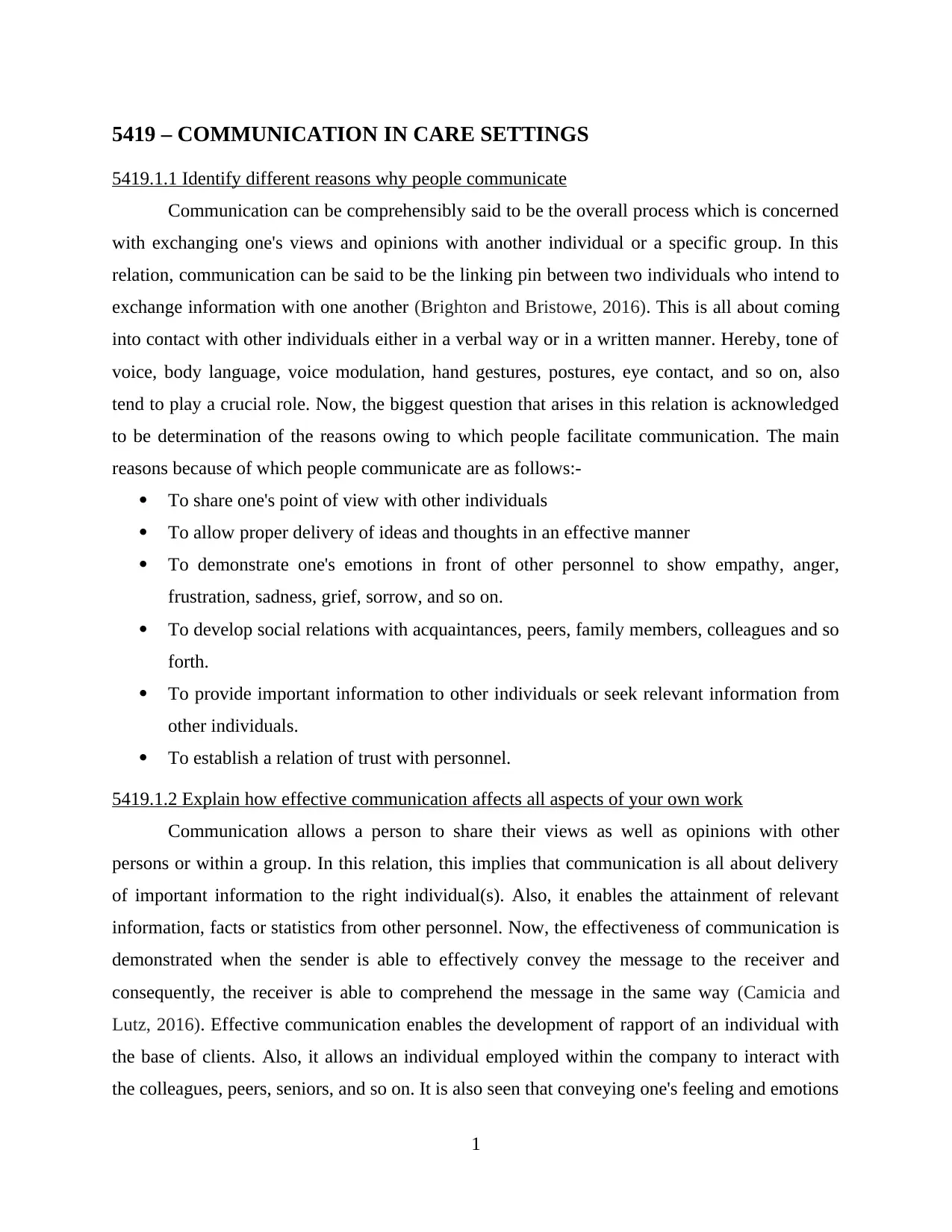
5419 – COMMUNICATION IN CARE SETTINGS
5419.1.1 Identify different reasons why people communicate
Communication can be comprehensibly said to be the overall process which is concerned
with exchanging one's views and opinions with another individual or a specific group. In this
relation, communication can be said to be the linking pin between two individuals who intend to
exchange information with one another (Brighton and Bristowe, 2016). This is all about coming
into contact with other individuals either in a verbal way or in a written manner. Hereby, tone of
voice, body language, voice modulation, hand gestures, postures, eye contact, and so on, also
tend to play a crucial role. Now, the biggest question that arises in this relation is acknowledged
to be determination of the reasons owing to which people facilitate communication. The main
reasons because of which people communicate are as follows:-
To share one's point of view with other individuals
To allow proper delivery of ideas and thoughts in an effective manner
To demonstrate one's emotions in front of other personnel to show empathy, anger,
frustration, sadness, grief, sorrow, and so on.
To develop social relations with acquaintances, peers, family members, colleagues and so
forth.
To provide important information to other individuals or seek relevant information from
other individuals.
To establish a relation of trust with personnel.
5419.1.2 Explain how effective communication affects all aspects of your own work
Communication allows a person to share their views as well as opinions with other
persons or within a group. In this relation, this implies that communication is all about delivery
of important information to the right individual(s). Also, it enables the attainment of relevant
information, facts or statistics from other personnel. Now, the effectiveness of communication is
demonstrated when the sender is able to effectively convey the message to the receiver and
consequently, the receiver is able to comprehend the message in the same way (Camicia and
Lutz, 2016). Effective communication enables the development of rapport of an individual with
the base of clients. Also, it allows an individual employed within the company to interact with
the colleagues, peers, seniors, and so on. It is also seen that conveying one's feeling and emotions
1
5419.1.1 Identify different reasons why people communicate
Communication can be comprehensibly said to be the overall process which is concerned
with exchanging one's views and opinions with another individual or a specific group. In this
relation, communication can be said to be the linking pin between two individuals who intend to
exchange information with one another (Brighton and Bristowe, 2016). This is all about coming
into contact with other individuals either in a verbal way or in a written manner. Hereby, tone of
voice, body language, voice modulation, hand gestures, postures, eye contact, and so on, also
tend to play a crucial role. Now, the biggest question that arises in this relation is acknowledged
to be determination of the reasons owing to which people facilitate communication. The main
reasons because of which people communicate are as follows:-
To share one's point of view with other individuals
To allow proper delivery of ideas and thoughts in an effective manner
To demonstrate one's emotions in front of other personnel to show empathy, anger,
frustration, sadness, grief, sorrow, and so on.
To develop social relations with acquaintances, peers, family members, colleagues and so
forth.
To provide important information to other individuals or seek relevant information from
other individuals.
To establish a relation of trust with personnel.
5419.1.2 Explain how effective communication affects all aspects of your own work
Communication allows a person to share their views as well as opinions with other
persons or within a group. In this relation, this implies that communication is all about delivery
of important information to the right individual(s). Also, it enables the attainment of relevant
information, facts or statistics from other personnel. Now, the effectiveness of communication is
demonstrated when the sender is able to effectively convey the message to the receiver and
consequently, the receiver is able to comprehend the message in the same way (Camicia and
Lutz, 2016). Effective communication enables the development of rapport of an individual with
the base of clients. Also, it allows an individual employed within the company to interact with
the colleagues, peers, seniors, and so on. It is also seen that conveying one's feeling and emotions
1
⊘ This is a preview!⊘
Do you want full access?
Subscribe today to unlock all pages.

Trusted by 1+ million students worldwide

to other persons by way of written or verbal communication allows the person to elevate their
sense of being. It leads to the development of healthy relations with other individuals. Talking as
well as listening to colleagues or the senior management leads to elevation of motivation levels.
This further inflates the potential and zeal of a person to work towards the accomplishment of
organisational goal and objectives within due course of time.
5419.1.3 Explain why it is important to observe an individual’s reactions when communicating
with them.
Communication is a process which can not be done in only in verbal manner, more part
of communication is carried on non- verbally. For example, when two people talk with each
other their body language, facial expressions, position in which they are standing or setting or
lets say any action or gestures all are involved in non- verbal communication. It is necessary to
individuals reaction because the words may have same meaning but reactions can not have the
same meaning. For example, when someone is asked whether he or she is in pain, then the replay
may be “Yes”, with a sad face and uncomfortable facial expression which may express the pain
of that person. All this can be seen when actions and reactions are observed properly (Davies and
Vora, 2016).
An individual's reactions states the involvement of that person who is in the conservation.
Communication gets better when people are communicating in action and reaction format, and if
one element is missing then that conversation may not have any meaning and may end with
incomplete manner. Therefore, it is important to note the reactions of people and also to show the
actions which makes people comfortable.
5419.3.1 Identify barriers to communication.
There can be many reasons which may fail the interpersonal communications of people.
For such active listening, clarification and reflection can help people while communicating with
each other. But skilled communicators needs have knowledge of the barrier which effect the
communication (Jansson, 2016). There are many barriers to communication which occur at many
stages while people communicate, some of them are:
People lack with attention, interest or distractions which may affect the understanding of
other person. While communicating it is important to have concentration over the things
being said by people because people may only reply once they what was said and
according to at what can be said in revert of it.
2
sense of being. It leads to the development of healthy relations with other individuals. Talking as
well as listening to colleagues or the senior management leads to elevation of motivation levels.
This further inflates the potential and zeal of a person to work towards the accomplishment of
organisational goal and objectives within due course of time.
5419.1.3 Explain why it is important to observe an individual’s reactions when communicating
with them.
Communication is a process which can not be done in only in verbal manner, more part
of communication is carried on non- verbally. For example, when two people talk with each
other their body language, facial expressions, position in which they are standing or setting or
lets say any action or gestures all are involved in non- verbal communication. It is necessary to
individuals reaction because the words may have same meaning but reactions can not have the
same meaning. For example, when someone is asked whether he or she is in pain, then the replay
may be “Yes”, with a sad face and uncomfortable facial expression which may express the pain
of that person. All this can be seen when actions and reactions are observed properly (Davies and
Vora, 2016).
An individual's reactions states the involvement of that person who is in the conservation.
Communication gets better when people are communicating in action and reaction format, and if
one element is missing then that conversation may not have any meaning and may end with
incomplete manner. Therefore, it is important to note the reactions of people and also to show the
actions which makes people comfortable.
5419.3.1 Identify barriers to communication.
There can be many reasons which may fail the interpersonal communications of people.
For such active listening, clarification and reflection can help people while communicating with
each other. But skilled communicators needs have knowledge of the barrier which effect the
communication (Jansson, 2016). There are many barriers to communication which occur at many
stages while people communicate, some of them are:
People lack with attention, interest or distractions which may affect the understanding of
other person. While communicating it is important to have concentration over the things
being said by people because people may only reply once they what was said and
according to at what can be said in revert of it.
2
Paraphrase This Document
Need a fresh take? Get an instant paraphrase of this document with our AI Paraphraser
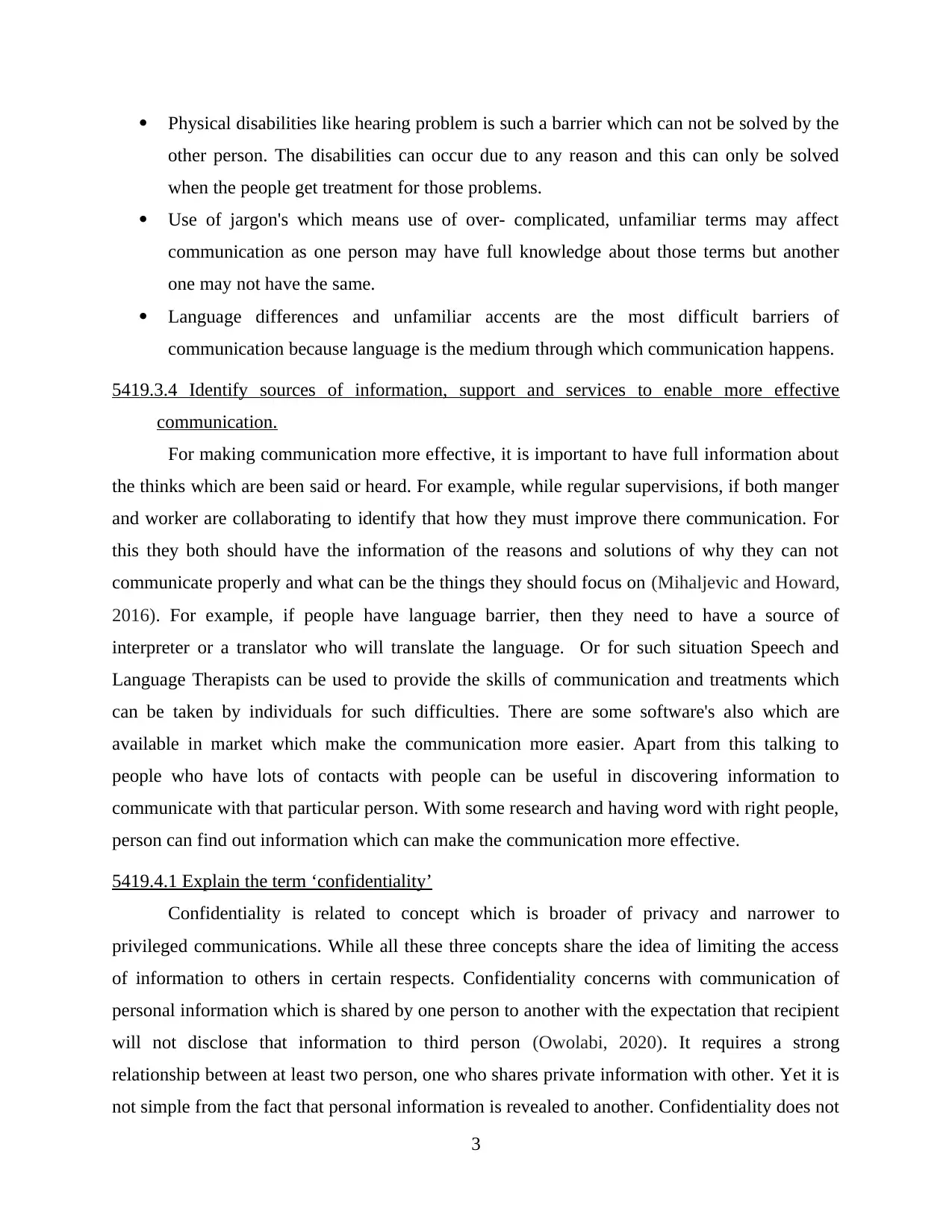
Physical disabilities like hearing problem is such a barrier which can not be solved by the
other person. The disabilities can occur due to any reason and this can only be solved
when the people get treatment for those problems.
Use of jargon's which means use of over- complicated, unfamiliar terms may affect
communication as one person may have full knowledge about those terms but another
one may not have the same.
Language differences and unfamiliar accents are the most difficult barriers of
communication because language is the medium through which communication happens.
5419.3.4 Identify sources of information, support and services to enable more effective
communication.
For making communication more effective, it is important to have full information about
the thinks which are been said or heard. For example, while regular supervisions, if both manger
and worker are collaborating to identify that how they must improve there communication. For
this they both should have the information of the reasons and solutions of why they can not
communicate properly and what can be the things they should focus on (Mihaljevic and Howard,
2016). For example, if people have language barrier, then they need to have a source of
interpreter or a translator who will translate the language. Or for such situation Speech and
Language Therapists can be used to provide the skills of communication and treatments which
can be taken by individuals for such difficulties. There are some software's also which are
available in market which make the communication more easier. Apart from this talking to
people who have lots of contacts with people can be useful in discovering information to
communicate with that particular person. With some research and having word with right people,
person can find out information which can make the communication more effective.
5419.4.1 Explain the term ‘confidentiality’
Confidentiality is related to concept which is broader of privacy and narrower to
privileged communications. While all these three concepts share the idea of limiting the access
of information to others in certain respects. Confidentiality concerns with communication of
personal information which is shared by one person to another with the expectation that recipient
will not disclose that information to third person (Owolabi, 2020). It requires a strong
relationship between at least two person, one who shares private information with other. Yet it is
not simple from the fact that personal information is revealed to another. Confidentiality does not
3
other person. The disabilities can occur due to any reason and this can only be solved
when the people get treatment for those problems.
Use of jargon's which means use of over- complicated, unfamiliar terms may affect
communication as one person may have full knowledge about those terms but another
one may not have the same.
Language differences and unfamiliar accents are the most difficult barriers of
communication because language is the medium through which communication happens.
5419.3.4 Identify sources of information, support and services to enable more effective
communication.
For making communication more effective, it is important to have full information about
the thinks which are been said or heard. For example, while regular supervisions, if both manger
and worker are collaborating to identify that how they must improve there communication. For
this they both should have the information of the reasons and solutions of why they can not
communicate properly and what can be the things they should focus on (Mihaljevic and Howard,
2016). For example, if people have language barrier, then they need to have a source of
interpreter or a translator who will translate the language. Or for such situation Speech and
Language Therapists can be used to provide the skills of communication and treatments which
can be taken by individuals for such difficulties. There are some software's also which are
available in market which make the communication more easier. Apart from this talking to
people who have lots of contacts with people can be useful in discovering information to
communicate with that particular person. With some research and having word with right people,
person can find out information which can make the communication more effective.
5419.4.1 Explain the term ‘confidentiality’
Confidentiality is related to concept which is broader of privacy and narrower to
privileged communications. While all these three concepts share the idea of limiting the access
of information to others in certain respects. Confidentiality concerns with communication of
personal information which is shared by one person to another with the expectation that recipient
will not disclose that information to third person (Owolabi, 2020). It requires a strong
relationship between at least two person, one who shares private information with other. Yet it is
not simple from the fact that personal information is revealed to another. Confidentiality does not
3
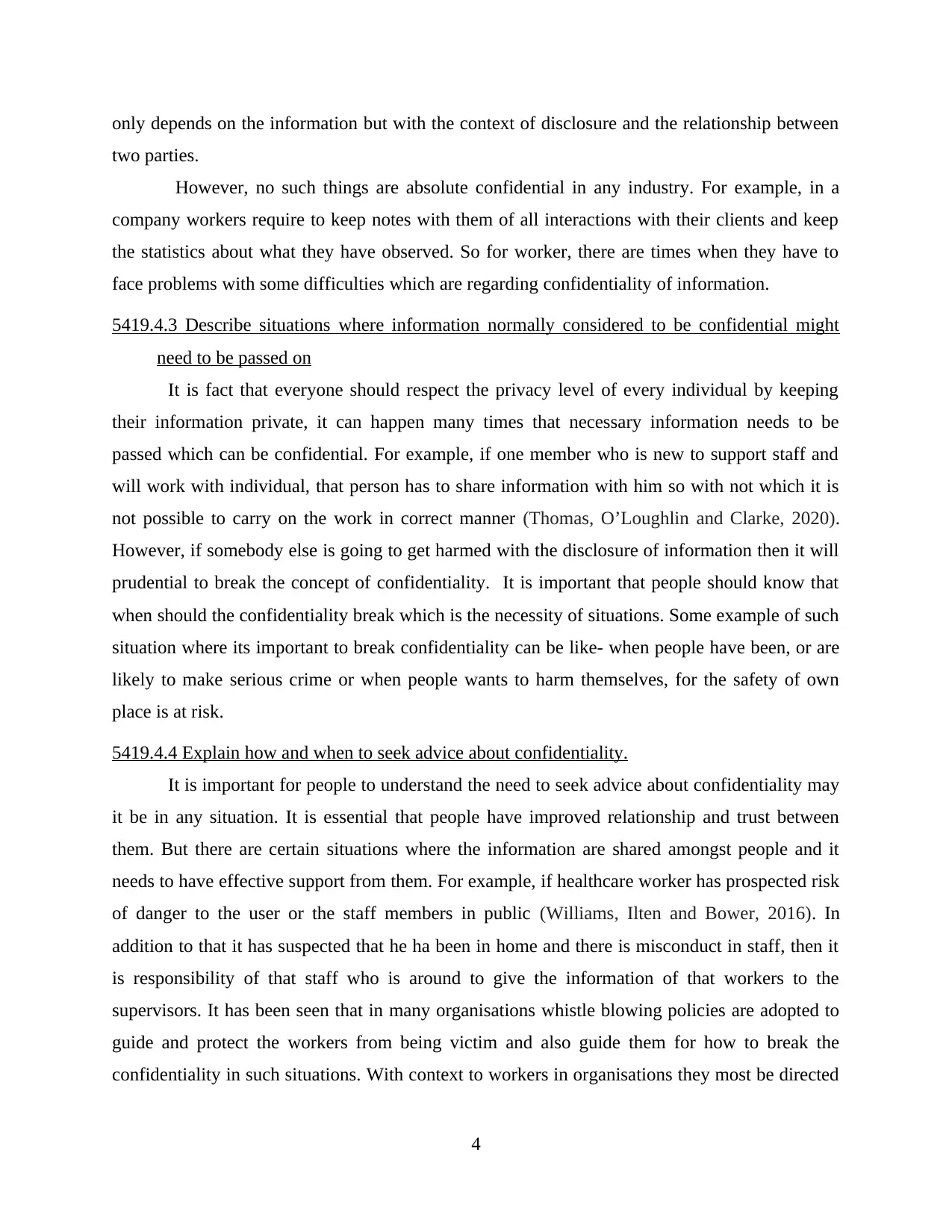
only depends on the information but with the context of disclosure and the relationship between
two parties.
However, no such things are absolute confidential in any industry. For example, in a
company workers require to keep notes with them of all interactions with their clients and keep
the statistics about what they have observed. So for worker, there are times when they have to
face problems with some difficulties which are regarding confidentiality of information.
5419.4.3 Describe situations where information normally considered to be confidential might
need to be passed on
It is fact that everyone should respect the privacy level of every individual by keeping
their information private, it can happen many times that necessary information needs to be
passed which can be confidential. For example, if one member who is new to support staff and
will work with individual, that person has to share information with him so with not which it is
not possible to carry on the work in correct manner (Thomas, O’Loughlin and Clarke, 2020).
However, if somebody else is going to get harmed with the disclosure of information then it will
prudential to break the concept of confidentiality. It is important that people should know that
when should the confidentiality break which is the necessity of situations. Some example of such
situation where its important to break confidentiality can be like- when people have been, or are
likely to make serious crime or when people wants to harm themselves, for the safety of own
place is at risk.
5419.4.4 Explain how and when to seek advice about confidentiality.
It is important for people to understand the need to seek advice about confidentiality may
it be in any situation. It is essential that people have improved relationship and trust between
them. But there are certain situations where the information are shared amongst people and it
needs to have effective support from them. For example, if healthcare worker has prospected risk
of danger to the user or the staff members in public (Williams, Ilten and Bower, 2016). In
addition to that it has suspected that he ha been in home and there is misconduct in staff, then it
is responsibility of that staff who is around to give the information of that workers to the
supervisors. It has been seen that in many organisations whistle blowing policies are adopted to
guide and protect the workers from being victim and also guide them for how to break the
confidentiality in such situations. With context to workers in organisations they most be directed
4
two parties.
However, no such things are absolute confidential in any industry. For example, in a
company workers require to keep notes with them of all interactions with their clients and keep
the statistics about what they have observed. So for worker, there are times when they have to
face problems with some difficulties which are regarding confidentiality of information.
5419.4.3 Describe situations where information normally considered to be confidential might
need to be passed on
It is fact that everyone should respect the privacy level of every individual by keeping
their information private, it can happen many times that necessary information needs to be
passed which can be confidential. For example, if one member who is new to support staff and
will work with individual, that person has to share information with him so with not which it is
not possible to carry on the work in correct manner (Thomas, O’Loughlin and Clarke, 2020).
However, if somebody else is going to get harmed with the disclosure of information then it will
prudential to break the concept of confidentiality. It is important that people should know that
when should the confidentiality break which is the necessity of situations. Some example of such
situation where its important to break confidentiality can be like- when people have been, or are
likely to make serious crime or when people wants to harm themselves, for the safety of own
place is at risk.
5419.4.4 Explain how and when to seek advice about confidentiality.
It is important for people to understand the need to seek advice about confidentiality may
it be in any situation. It is essential that people have improved relationship and trust between
them. But there are certain situations where the information are shared amongst people and it
needs to have effective support from them. For example, if healthcare worker has prospected risk
of danger to the user or the staff members in public (Williams, Ilten and Bower, 2016). In
addition to that it has suspected that he ha been in home and there is misconduct in staff, then it
is responsibility of that staff who is around to give the information of that workers to the
supervisors. It has been seen that in many organisations whistle blowing policies are adopted to
guide and protect the workers from being victim and also guide them for how to break the
confidentiality in such situations. With context to workers in organisations they most be directed
4
⊘ This is a preview!⊘
Do you want full access?
Subscribe today to unlock all pages.

Trusted by 1+ million students worldwide

for the situations were they need to share and were they don't need to. Apart from this they must
know with whom they need to share information and with whom they do not have to.
5420 – HANDLING INFORMATION IN CARE SETTINGS
5420.1.1 Identify the legislation that relates to the recording, storage and sharing of information
in care settings
The legislation that is related to the recording, storage and sharing of information in care
settings is the Data Protection Act of 2018 which includes the General Data Protection
Regulation (GDPR). It was formulated a long time ago but due to technological advancement it
had changed a lot since then and the last updated version was given in the year 2018. It bridges
the gap between privacy and rights. It doesn't compromise with the privacy of the customers
neither allows the organization to hold data of the consumers rather it keeps the personal
information safe so that it cannot be misused in any circumstances (Bor and Miller, 2019). It
does not allow anyone to use the data except the organization as it is highly regulated and
accurate. It stores a limited amount of data and that too for a limited period of time and after that
time it automatically gets deleted so that the personal information can be used precisely and thus
closing the scope of mismanagement.
5420.1.2 Explain why it is important to have secure systems for recording and storing
information in a care setting
It is very important to have a secure system for recording and storing information in a
care setting because the data that are used here are highly personal and if they are misused, it
makes the person vulnerable. Care settings have information regarding customer like their
picture, name, address, mobile number, etc. which have to be kept in a secure system to ensure
full privacy. As well as they could carry information about the person's health which can be very
injurious to the individual if it goes into the wrong hands (Dambaugh and Ecklund, 2016).
Therefore, the information in the care setting needed to be highly regulated so that it can meet all
the rules, regulations, and laws that are made for privacy. In case of any breach in the system, the
strictest action must be taken and efforts should be made to keep things up to date. There is much
legislation that is made in context with it but the most used is the Data Protection Act which can
act as a guideline for care setting units for privacy-related issues and concerns.
5
know with whom they need to share information and with whom they do not have to.
5420 – HANDLING INFORMATION IN CARE SETTINGS
5420.1.1 Identify the legislation that relates to the recording, storage and sharing of information
in care settings
The legislation that is related to the recording, storage and sharing of information in care
settings is the Data Protection Act of 2018 which includes the General Data Protection
Regulation (GDPR). It was formulated a long time ago but due to technological advancement it
had changed a lot since then and the last updated version was given in the year 2018. It bridges
the gap between privacy and rights. It doesn't compromise with the privacy of the customers
neither allows the organization to hold data of the consumers rather it keeps the personal
information safe so that it cannot be misused in any circumstances (Bor and Miller, 2019). It
does not allow anyone to use the data except the organization as it is highly regulated and
accurate. It stores a limited amount of data and that too for a limited period of time and after that
time it automatically gets deleted so that the personal information can be used precisely and thus
closing the scope of mismanagement.
5420.1.2 Explain why it is important to have secure systems for recording and storing
information in a care setting
It is very important to have a secure system for recording and storing information in a
care setting because the data that are used here are highly personal and if they are misused, it
makes the person vulnerable. Care settings have information regarding customer like their
picture, name, address, mobile number, etc. which have to be kept in a secure system to ensure
full privacy. As well as they could carry information about the person's health which can be very
injurious to the individual if it goes into the wrong hands (Dambaugh and Ecklund, 2016).
Therefore, the information in the care setting needed to be highly regulated so that it can meet all
the rules, regulations, and laws that are made for privacy. In case of any breach in the system, the
strictest action must be taken and efforts should be made to keep things up to date. There is much
legislation that is made in context with it but the most used is the Data Protection Act which can
act as a guideline for care setting units for privacy-related issues and concerns.
5
Paraphrase This Document
Need a fresh take? Get an instant paraphrase of this document with our AI Paraphraser
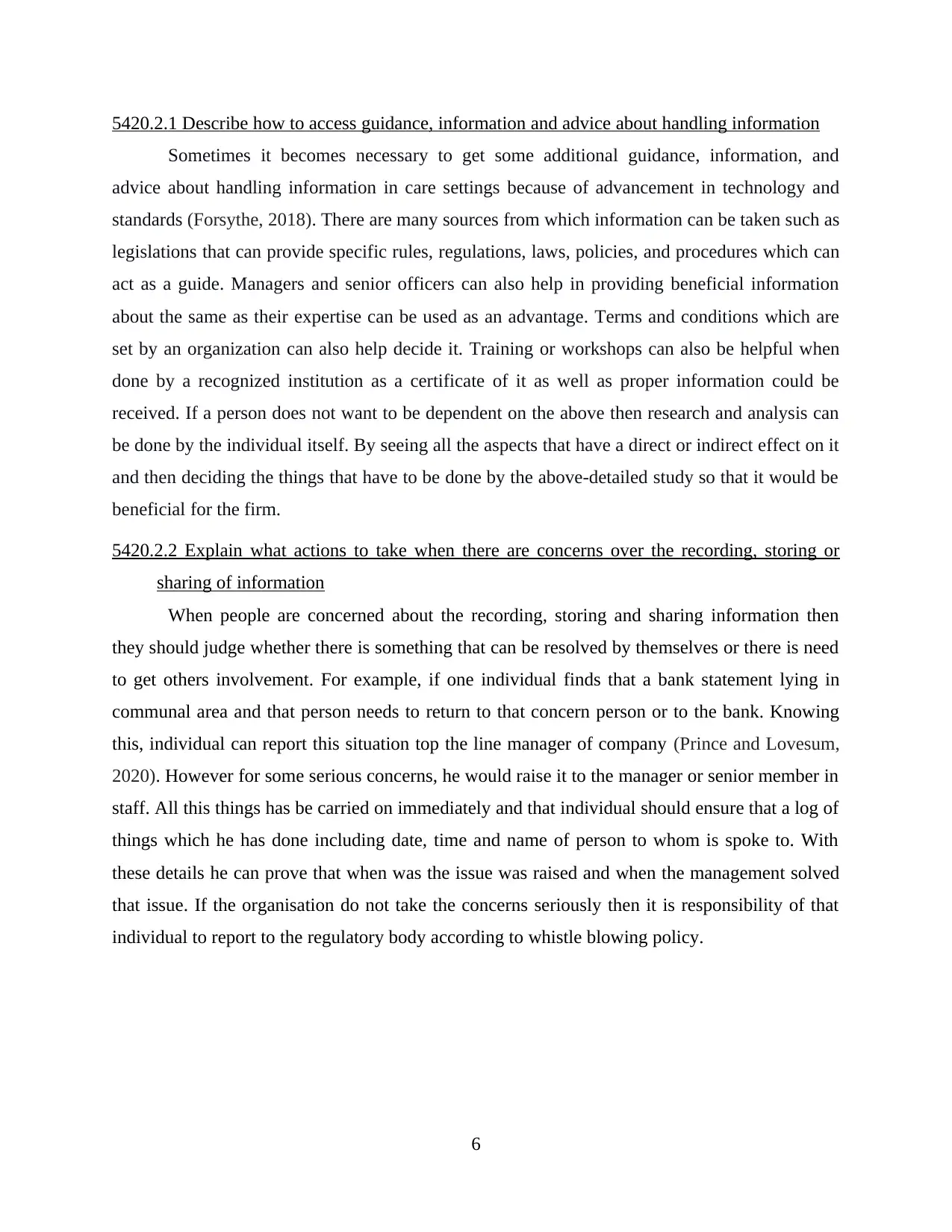
5420.2.1 Describe how to access guidance, information and advice about handling information
Sometimes it becomes necessary to get some additional guidance, information, and
advice about handling information in care settings because of advancement in technology and
standards (Forsythe, 2018). There are many sources from which information can be taken such as
legislations that can provide specific rules, regulations, laws, policies, and procedures which can
act as a guide. Managers and senior officers can also help in providing beneficial information
about the same as their expertise can be used as an advantage. Terms and conditions which are
set by an organization can also help decide it. Training or workshops can also be helpful when
done by a recognized institution as a certificate of it as well as proper information could be
received. If a person does not want to be dependent on the above then research and analysis can
be done by the individual itself. By seeing all the aspects that have a direct or indirect effect on it
and then deciding the things that have to be done by the above-detailed study so that it would be
beneficial for the firm.
5420.2.2 Explain what actions to take when there are concerns over the recording, storing or
sharing of information
When people are concerned about the recording, storing and sharing information then
they should judge whether there is something that can be resolved by themselves or there is need
to get others involvement. For example, if one individual finds that a bank statement lying in
communal area and that person needs to return to that concern person or to the bank. Knowing
this, individual can report this situation top the line manager of company (Prince and Lovesum,
2020). However for some serious concerns, he would raise it to the manager or senior member in
staff. All this things has be carried on immediately and that individual should ensure that a log of
things which he has done including date, time and name of person to whom is spoke to. With
these details he can prove that when was the issue was raised and when the management solved
that issue. If the organisation do not take the concerns seriously then it is responsibility of that
individual to report to the regulatory body according to whistle blowing policy.
6
Sometimes it becomes necessary to get some additional guidance, information, and
advice about handling information in care settings because of advancement in technology and
standards (Forsythe, 2018). There are many sources from which information can be taken such as
legislations that can provide specific rules, regulations, laws, policies, and procedures which can
act as a guide. Managers and senior officers can also help in providing beneficial information
about the same as their expertise can be used as an advantage. Terms and conditions which are
set by an organization can also help decide it. Training or workshops can also be helpful when
done by a recognized institution as a certificate of it as well as proper information could be
received. If a person does not want to be dependent on the above then research and analysis can
be done by the individual itself. By seeing all the aspects that have a direct or indirect effect on it
and then deciding the things that have to be done by the above-detailed study so that it would be
beneficial for the firm.
5420.2.2 Explain what actions to take when there are concerns over the recording, storing or
sharing of information
When people are concerned about the recording, storing and sharing information then
they should judge whether there is something that can be resolved by themselves or there is need
to get others involvement. For example, if one individual finds that a bank statement lying in
communal area and that person needs to return to that concern person or to the bank. Knowing
this, individual can report this situation top the line manager of company (Prince and Lovesum,
2020). However for some serious concerns, he would raise it to the manager or senior member in
staff. All this things has be carried on immediately and that individual should ensure that a log of
things which he has done including date, time and name of person to whom is spoke to. With
these details he can prove that when was the issue was raised and when the management solved
that issue. If the organisation do not take the concerns seriously then it is responsibility of that
individual to report to the regulatory body according to whistle blowing policy.
6
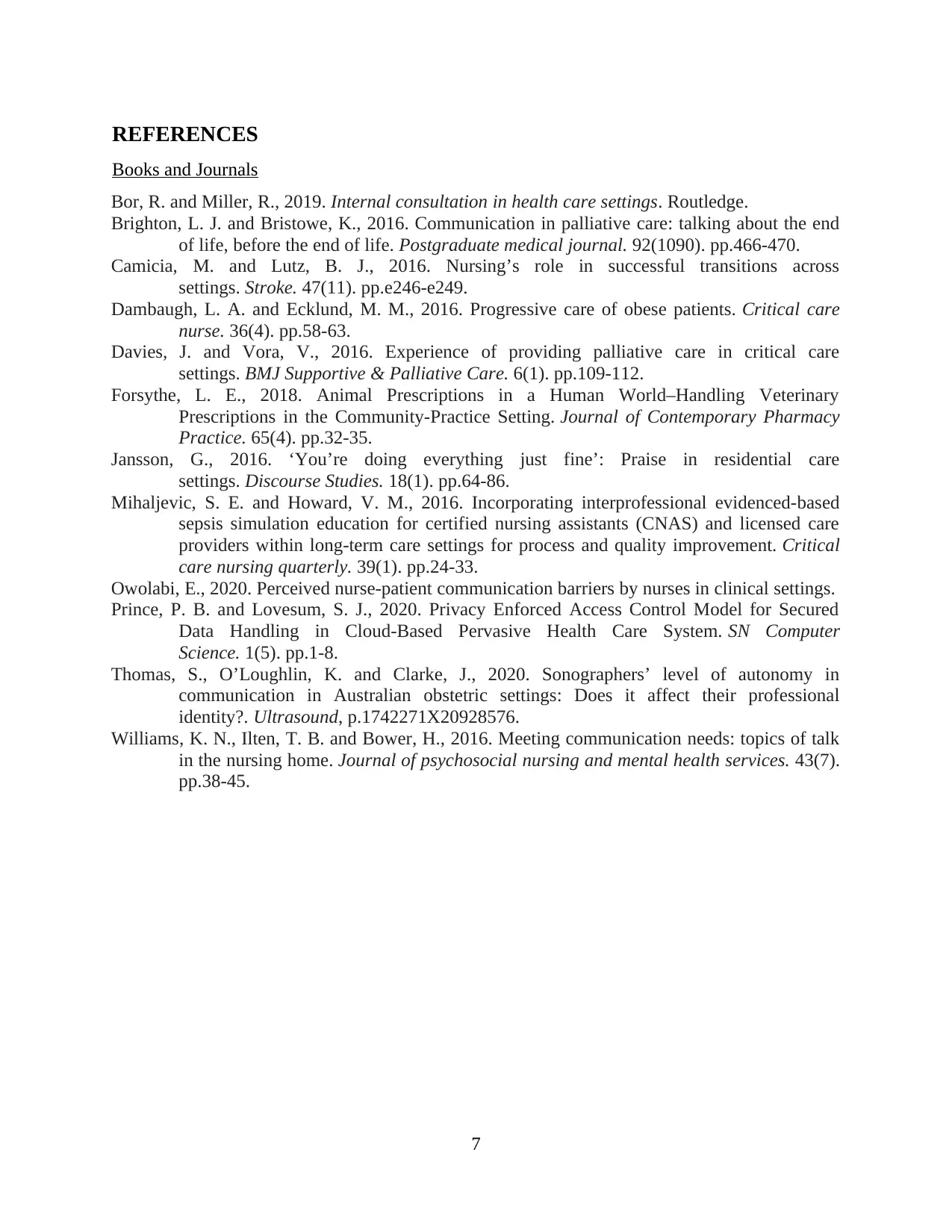
REFERENCES
Books and Journals
Bor, R. and Miller, R., 2019. Internal consultation in health care settings. Routledge.
Brighton, L. J. and Bristowe, K., 2016. Communication in palliative care: talking about the end
of life, before the end of life. Postgraduate medical journal. 92(1090). pp.466-470.
Camicia, M. and Lutz, B. J., 2016. Nursing’s role in successful transitions across
settings. Stroke. 47(11). pp.e246-e249.
Dambaugh, L. A. and Ecklund, M. M., 2016. Progressive care of obese patients. Critical care
nurse. 36(4). pp.58-63.
Davies, J. and Vora, V., 2016. Experience of providing palliative care in critical care
settings. BMJ Supportive & Palliative Care. 6(1). pp.109-112.
Forsythe, L. E., 2018. Animal Prescriptions in a Human World–Handling Veterinary
Prescriptions in the Community-Practice Setting. Journal of Contemporary Pharmacy
Practice. 65(4). pp.32-35.
Jansson, G., 2016. ‘You’re doing everything just fine’: Praise in residential care
settings. Discourse Studies. 18(1). pp.64-86.
Mihaljevic, S. E. and Howard, V. M., 2016. Incorporating interprofessional evidenced-based
sepsis simulation education for certified nursing assistants (CNAS) and licensed care
providers within long-term care settings for process and quality improvement. Critical
care nursing quarterly. 39(1). pp.24-33.
Owolabi, E., 2020. Perceived nurse-patient communication barriers by nurses in clinical settings.
Prince, P. B. and Lovesum, S. J., 2020. Privacy Enforced Access Control Model for Secured
Data Handling in Cloud-Based Pervasive Health Care System. SN Computer
Science. 1(5). pp.1-8.
Thomas, S., O’Loughlin, K. and Clarke, J., 2020. Sonographers’ level of autonomy in
communication in Australian obstetric settings: Does it affect their professional
identity?. Ultrasound, p.1742271X20928576.
Williams, K. N., Ilten, T. B. and Bower, H., 2016. Meeting communication needs: topics of talk
in the nursing home. Journal of psychosocial nursing and mental health services. 43(7).
pp.38-45.
7
Books and Journals
Bor, R. and Miller, R., 2019. Internal consultation in health care settings. Routledge.
Brighton, L. J. and Bristowe, K., 2016. Communication in palliative care: talking about the end
of life, before the end of life. Postgraduate medical journal. 92(1090). pp.466-470.
Camicia, M. and Lutz, B. J., 2016. Nursing’s role in successful transitions across
settings. Stroke. 47(11). pp.e246-e249.
Dambaugh, L. A. and Ecklund, M. M., 2016. Progressive care of obese patients. Critical care
nurse. 36(4). pp.58-63.
Davies, J. and Vora, V., 2016. Experience of providing palliative care in critical care
settings. BMJ Supportive & Palliative Care. 6(1). pp.109-112.
Forsythe, L. E., 2018. Animal Prescriptions in a Human World–Handling Veterinary
Prescriptions in the Community-Practice Setting. Journal of Contemporary Pharmacy
Practice. 65(4). pp.32-35.
Jansson, G., 2016. ‘You’re doing everything just fine’: Praise in residential care
settings. Discourse Studies. 18(1). pp.64-86.
Mihaljevic, S. E. and Howard, V. M., 2016. Incorporating interprofessional evidenced-based
sepsis simulation education for certified nursing assistants (CNAS) and licensed care
providers within long-term care settings for process and quality improvement. Critical
care nursing quarterly. 39(1). pp.24-33.
Owolabi, E., 2020. Perceived nurse-patient communication barriers by nurses in clinical settings.
Prince, P. B. and Lovesum, S. J., 2020. Privacy Enforced Access Control Model for Secured
Data Handling in Cloud-Based Pervasive Health Care System. SN Computer
Science. 1(5). pp.1-8.
Thomas, S., O’Loughlin, K. and Clarke, J., 2020. Sonographers’ level of autonomy in
communication in Australian obstetric settings: Does it affect their professional
identity?. Ultrasound, p.1742271X20928576.
Williams, K. N., Ilten, T. B. and Bower, H., 2016. Meeting communication needs: topics of talk
in the nursing home. Journal of psychosocial nursing and mental health services. 43(7).
pp.38-45.
7
⊘ This is a preview!⊘
Do you want full access?
Subscribe today to unlock all pages.

Trusted by 1+ million students worldwide
1 out of 9
Related Documents
Your All-in-One AI-Powered Toolkit for Academic Success.
+13062052269
info@desklib.com
Available 24*7 on WhatsApp / Email
![[object Object]](/_next/static/media/star-bottom.7253800d.svg)
Unlock your academic potential
Copyright © 2020–2025 A2Z Services. All Rights Reserved. Developed and managed by ZUCOL.





